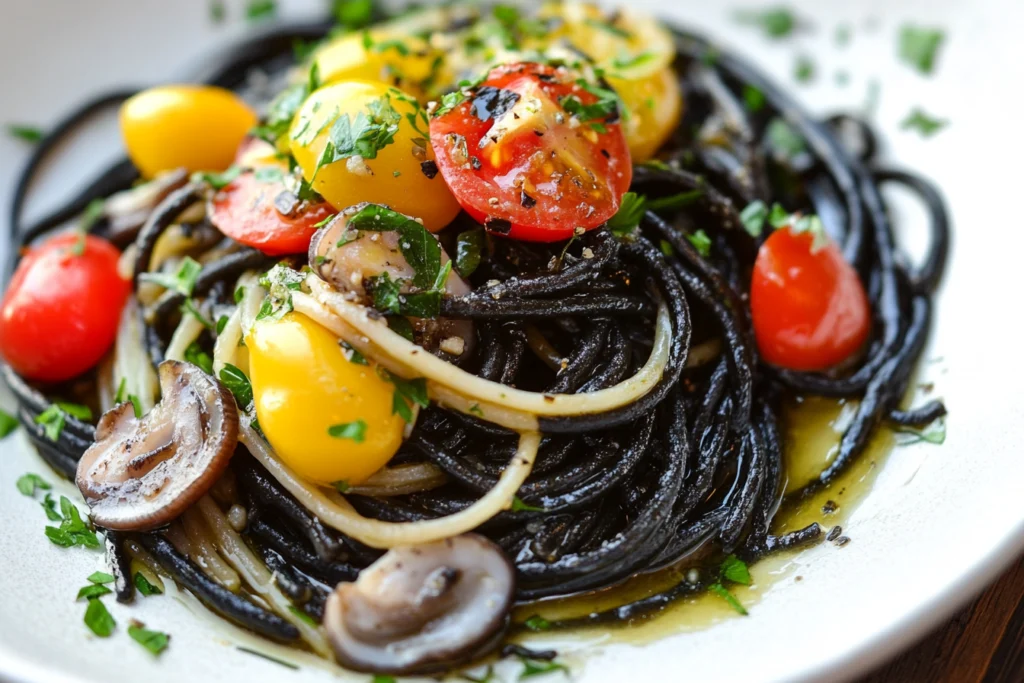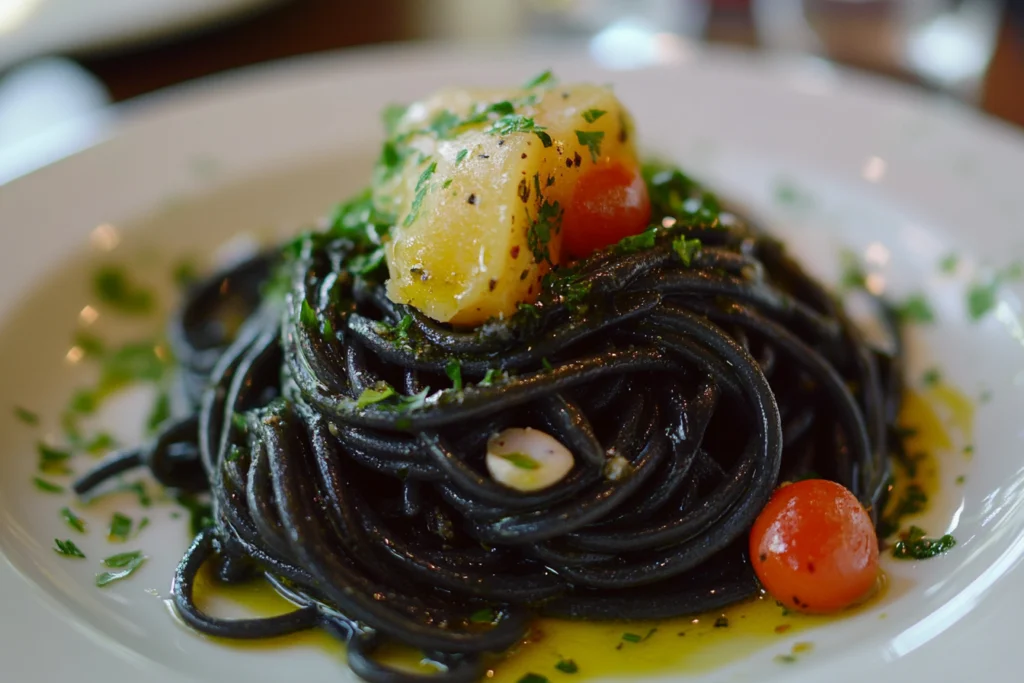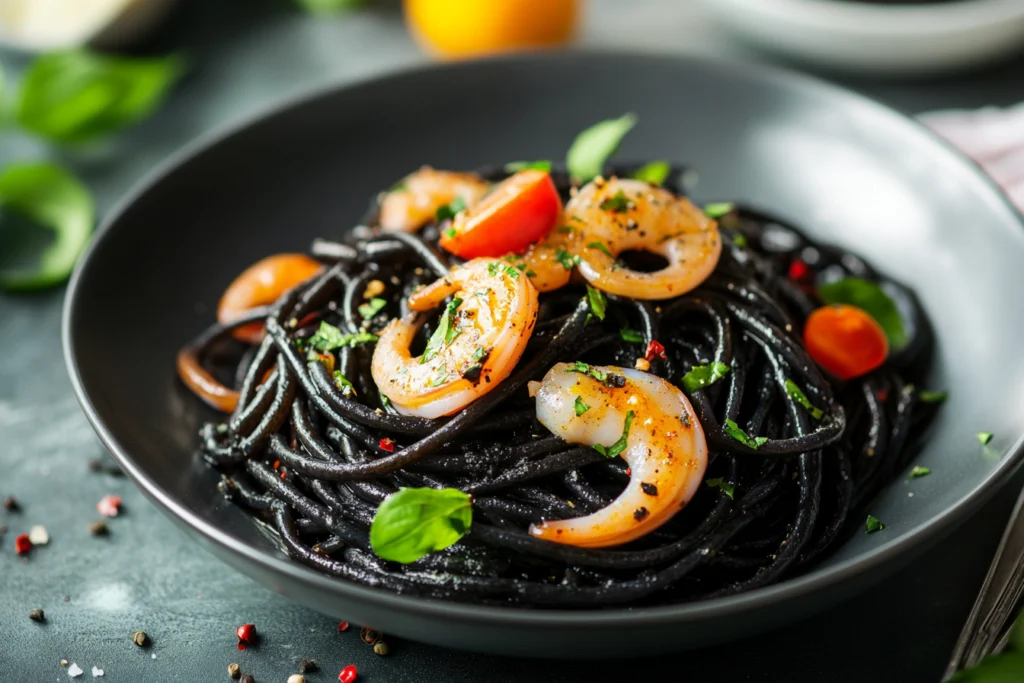Every year, over 200 tons of squid ink are harvested globally. This creates the striking black pasta known as squid ink spaghetti. It’s a dish that’s gone from a coastal Mediterranean specialty to a modern culinary sensation.
This pasta isn’t just visually dramatic. Its rich, briny taste and historic roots make it a favorite. Chefs and adventurous eaters love it.
Imagine biting into a strand of jet-black pasta. It carries the ocean’s essence, paired with plump shrimp and a drizzle of olive oil. Squid ink spaghetti isn’t just a meal—it’s a journey through centuries of Mediterranean tradition.
Now, it’s celebrated in trendy U.S. restaurants from New York to Los Angeles. This article will show you how to master its preparation. You’ll learn how to select the right ingredients and serve it with confidence.
Key Takeaways
- Squid ink spaghetti combines ancient culinary techniques with modern gourmet trends.
- Its bold black color comes directly from squid ink, a natural ingredient used for millennia.
- The dish’s popularity in the U.S. has surged, appearing on menus nationwide.
- It offers a unique umami flavor profile that pairs well with seafood and herbs.
- Making it at home requires attention to ingredient quality and proper cooking techniques.
What Is Squid Ink Spaghetti and Its Mediterranean Origins
Imagine a pasta dish dyed deep black by the ocean’s mystery—ink pasta. This dish, rooted in Mediterranean traditions, tells a story of resourcefulness and cultural pride. From ancient fishing villages to modern kitchens, its journey shows how necessity and creativity shaped a culinary icon.

The Fascinating History of Squid Ink in Mediterranean Cuisine
Long before it became a gourmet staple, squid ink was a survival tool. Fishermen in coastal regions like Sicily and Greece used the ink to flavor and color meals made from squid catches. By the 16th century, recipes began appearing in coastal cookbooks.
A key shift occurred in the 19th century when industrial fishing expanded ink availability. Today, its history is preserved in dishes like spaghetti neri and Spanish arroz negro.
How Squid Ink Became a Prized Pasta Ingredient
What turned this humble byproduct into a sought-after ingredient?
- Unique texture and mild briny taste
- Visual appeal for chefs seeking innovation
- Recognition of its nutritional benefits
By the 20th century, upscale restaurants began showcasing ink pasta as a symbol of culinary artistry.
Regional Variations Across Mediterranean Countries
Explore how different cultures adapt ink pasta:
| Country | Signature Dish | Key Ingredients |
|---|---|---|
| Italy | Sicilian spaghetti neri | Local squid ink, clams, chili flakes |
| Spain | Valencian arroz negro | Ink-infused rice, saffron, seafood |
| Greece | Cretan mavrogialoto | Olive oil, fennel, mussels |
Each variation reflects local tastes and resources, proving ink pasta’s adaptability across the Mediterranean.
Health Benefits and Nutritional Profile of Squid Ink
Squid pasta is more than just bold flavor and striking color. Its base, squid ink, brings unique nutritional benefits. It’s packed with antioxidants that fight cell damage. It also has iron and zinc, which boost energy and immunity.
These nutrients, along with the protein in the ink, make the dish satisfying and nourishing. This combination creates a meal that’s both tasty and good for you.
- Antioxidants: Protect cells from oxidative stress linked to aging and disease.
- Iron and zinc: Vital for blood health and immune function.
- Amino acids: Aid muscle repair and metabolic processes.
Compared to regular pasta, squid pasta has fewer calories. This is thanks to its lean squid ink content. The protein in the ink also helps you feel full longer, making it a great choice for balanced meals.
While research is ongoing, early studies suggest squid pasta may have benefits for heart health and brain function. Enjoying this pasta doesn’t mean you’re sacrificing nutrition. Each bite offers the natural goodness of seafood without too much fat.
Pair it with fresh vegetables and herbs to increase your vitamin intake. Just remember, moderation is key. Squid pasta can be a tasty addition to a varied diet.
Essential Ingredients for Authentic Squid Ink Spaghetti
Creating a great black squid ink pasta recipe starts with the right ingredients. Each part adds to the dish’s salty taste and smooth feel. Here’s what you need for a true Mediterranean dish.
Selecting the Best Squid Ink
The key ingredient is pure squid ink. Choose liquid squid ink from trusted brands like Squid Ink Co. or Ocean’s Pride. It should be a deep indigo color and free of artificial stuff. Keep it in a cool, dark spot for up to a year. Once you open it, keep it in the fridge and use it within a month.
Pasta Options: Pre-made vs. Homemade
For easy cooking, pick pre-made squid ink pasta from De Cecco or Barilla. Making your own pasta needs just three things: flour, eggs, and squid ink powder. Homemade pasta soaks up flavors better but takes more time.
Complementary Seafood and Vegetables
- Seafood: Use big shrimp, salty clams, or sweet scallops for extra flavor.
- Vegetables: Add bell peppers, sun-dried tomatoes, and garlic to balance the ink. Roasted cherry tomatoes in olive oil are also great.
Must-Have Herbs and Seasonings
Finish with herbs that bring out the ink’s richness. Fresh parsley and oregano add a bright touch. Red pepper flakes or chili oil add warmth. Use extra-virgin olive oil from California Olive Ranch for the best taste.
By carefully choosing these ingredients, your black squid ink pasta recipe will be a true Mediterranean dish. It will highlight the squid ink’s unique flavor without overpowering it.
Kitchen Equipment You’ll Need for Perfect Black Pasta
Preparing squid ink spaghetti needs the right tools. You’ll need a pasta machine like the Imperia 001 or Breville Kitchen Machine. These machines help roll dough evenly without tearing. If you prefer manual, a hand-cranked Atlas pasta maker is a good choice.
- Pasta machine: Key for shaping dough into even strands
- Large pot: Stainless steel or enameled cast iron to prevent discoloration
- Mixing bowl: Non-reactive glass or plastic to mix ink and flour
- Cutting tool: A sharp knife or fettuccine cutter for clean edges
- Drying rack: Wire mesh rack to air-dry pasta before cooking
- Measuring spoons: Precision tools for squid ink portions
| Tool | Purpose | Top Brands |
|---|---|---|
| Pasta machine | Rolls dough to consistent thickness | Imperia, Breville |
| Cooking pot | Boils pasta without metallic taste | Lodge cast iron, All-Clad |
| Rolling pin | Alternative to machine for small batches | Rosisoft hardwood |
| Drying rack | Air circulation prevents sticking | Cuisipro, OXO |
Use a non-stick colander to drain pasta without losing ink’s bold color. For small kitchens, try a rolling pin with a cookie cutter for rustic shapes. Always clean tools right away with warm, soapy water to remove ink stains. Good tools make your squid ink spaghetti silky and vibrant every time.

Step-by-Step Guide to Making Squid Ink Spaghetti From Scratch
Learning to make squid ink spaghetti starts with knowing its basic parts. This guide will walk you through each step, from making the dough to serving the dish. Follow these steps for a dish that tastes like it came from a restaurant.
Preparing Your Homemade Pasta Dough
- Mix 2 cups “00” flour (like Caputo) into a volcano-shaped mound on a clean surface.
- Crack 4 large eggs into the center and add a pinch of sea salt.
- Whisk eggs gently, then gradually incorporate flour with a fork until a shaggy dough forms.
- Knead vigorously for 8-10 minutes until smooth. Wrap in plastic and rest for 30 minutes.
Incorporating the Squid Ink
Squid ink stains surfaces forever, so handle it carefully. Add 1-2 teaspoons of pure squid ink (avoid diluted varieties) to the rested dough. Knead briefly to keep the dough elastic. Aim for a charcoal-gray color without overworking.
Rolling and Cutting Techniques
“When working with squid ink pasta, prioritize gentle handling to preserve color vibrancy,” says Chef Marco Conti of Rome’s L’Artevino.
- Divide dough into portions and roll through a pasta machine on the thickest setting first.
- Gradually narrow settings to 1/16″ thickness. Dust with semolina to prevent sticking.
- Use a spaghetti attachment or hand-cut strips to 1/8″ width. Air-dry noodles 10-15 minutes before cooking.
Cooking Your Fresh Ink Pasta
Bring heavily salted water to a rolling boil. Add pasta and cook 2-4 minutes (fresh pasta cooks faster than dried). Taste frequently to achieve al dente texture. Drain immediately when firm to bite—overcooking causes color fading.
Pair your creation with simple sauces like garlic-oil or seafood-based creations to let the pasta’s earthy depth shine. Now you’re ready to craft authentic pasta squid ink recipe dishes at home!
Classic Sauces and Flavor Pairings for Pasta Squid Ink Recipe
Choosing the right sauce can make your squid pasta even better. Try these Mediterranean-inspired options to find the perfect match.
Seafood-Based Sauce Options
Seafood sauces bring out the pasta’s oceanic taste. Here are some great squid pasta pairings:
- Garlic and White Wine: Simmer chopped clams or mussels in white wine with garlic and chili flakes for a briny base.
- Tomato-Saffron: Combine sun-ripened tomatoes with saffron threads and a hint of olive oil for a vibrant contrast.
- Lemon and Shrimp: Quick-toss cooked shrimp with lemon zest, capers, and parsley for a bright finish.
Light vs. Creamy Sauce Considerations
Decide between light or creamy sauces based on your preference:
- Light Sauces: Opt for olive oil, garlic, and fresh herbs to let the squid ink’s flavor shine. Ideal for summer meals.
- Rich Sauces: Creamy sauces like mascarpone or béchamel add silkiness. Use sparingly to avoid masking the pasta’s uniqueness.
Wine and Herb Combinations
Enhance your dish with these pairings:
Pair with crisp squid pasta with whites like Vermentino or Pinot Grigio. For herbs, mix fresh parsley, basil, and oregano. A sprinkle of chili flakes adds warmth without overpowering. Experiment with lemon juice to brighten richness.
Common Mistakes to Avoid When Cooking Black Squid Ink Pasta
Mastering ink pasta needs careful attention. Many home cooks miss simple steps that affect taste and look. Here are tips to avoid common mistakes:
- Overloading the ink ratio: Too much squid ink makes pasta bitter. Start with 1 tsp per 100g flour, then adjust. Always taste the dough before adding more.
- Cooking time neglect: Black pasta cooks quicker than regular pasta. Check if it’s ready 1-2 minutes before the package says. This prevents it from becoming mushy.
- Clashing flavors: Acidic sauces like tomato-based dishes don’t mix well with ink’s brininess. Try garlic, chili, or white wine sauces instead.
- Color bleeding: Aluminum pans can make ink pasta lose its color. Use stainless steel or non-stick pots to keep it jet-black.
- Poor storage: Cool pasta completely before storing. Use airtight containers from brands like De Cecco or La Molisana to keep it fresh.
Always check the dough’s consistency early. Squid ink can dry out quickly. For sauces, a little olive oil brings out the ink’s umami without overpowering it. Treat ink pasta like delicate seafood, not regular noodles. With these tips, every bite will show the ocean’s depth perfectly.
Where to Source Quality Squid Ink in the United States
Starting your black squid ink pasta recipe means finding the freshest squid ink. You can find it in coastal cities or inland areas. These options help you get the best ingredients for your dish.
Specialty Stores and Markets
In big cities, you can find specialty ingredients easily. New York’s Eataly NYC has imported squid ink near the Italian pantry. Chicago’s Green City Market offers local and Mediterranean products. San Francisco’s Ferry Plaza Marketplace imports squid ink from Spain and Italy.
Miami’s La Mariscal Market is great for Latin and Mediterranean goods. It’s a top spot for authentic squid ink.
Online Retailers with the Best Products
Online stores make it easy to get squid ink anywhere. Amazon has brands like La Trattoria for $8–$12. The Savory Pantry offers premium squid ink ($15–$20). Williams-Sonoma sells it with pasta-making kits.
Always check seller reviews to avoid bad products.
What to Look for When Purchasing Squid Ink
Quality depends on clear labels. Look for:
- Expiration dates within 18 months of purchase
- Country of origin (Spain, Italy, or Greece preferred)
- No additives like artificial colorants
- Dark, airtight packaging to preserve freshness
Choose 100% pure ink—avoid blends with soy or preservatives. Store it in a cool, dark place until you use it.
Impressive Serving Suggestions and Presentation Tips
Make your pasta squid ink recipe stand out with these presentation tips. The dark pasta needs bright colors to balance it. Use white plates or black slate to highlight the pasta’s color.
- Color Contrast: Add red cherry tomatoes, bright basil, or sautéed shrimp for color. A sprinkle of lemon zest adds tang and looks great.
- Serving Vessels: Choose shallow bowls or slate platters to keep the dish balanced. A white plate makes the pasta’s color pop.
- Garnishing Techniques: Drizzle olive oil in a zigzag over the pasta. Top with microgreens or edible flowers for a fresh touch.
“The best squid ink dishes let the ingredient’s uniqueness shine without overshadowing its partners,” says Chef Marco Conti of Rome’s acclaimed Trattoria del Mare. “Balance is key.”
Pair your pasta squid ink recipe with a crisp white wine like Vermentino. Add side dishes like briny olives, grilled calamari, or a lemon-herb salad. For dessert, try a light citrus tart to contrast the savory squid ink.
- Portion Control: Use 1.5 cups of pasta per serving. This lets you enjoy the flavor without feeling too full.
- Final Touch: Dust with smoked paprika or chili flakes for a smoky aroma and contrast.
Remember, presentation is as important as cooking. A well-plated dish turns a meal into an experience. It invites guests to enjoy every bite of your pasta squid ink recipe.
Conclusion: Embracing the Bold Flavors of Mediterranean Squid Ink Cuisine
Squid ink spaghetti turns a meal into a journey. It mixes old traditions with new ideas, showing the Mediterranean’s deep food history. Every step, from mixing ink into dough to picking the right sauce, adds to your cooking adventure.
The dish’s dark color and salty taste make it a highlight of any meal. It pairs well with seafood or herbs, bringing the sea’s flavor to your plate. Learning to make it lets you serve something unforgettable, whether it’s for a simple dinner or a big event.
Now that you know how to make it, try new things. Add chili flakes, use lemon zest, or mix different sauces. These changes keep your dish exciting while staying true to its roots. Squid ink spaghetti’s popularity in American restaurants and homes shows its lasting appeal.
Trying this pasta is more than just following a recipe. It’s about joining a tradition that values both new ideas and old ways. With practice, you’ll make a dish that surprises and pleases. Embrace the dark color and sea flavors, and let them spark your next cooking project. This pasta’s bold nature makes it a great challenge for any cook, blending creativity with skill.
FAQ
What is squid ink spaghetti?
Squid ink spaghetti is a special pasta made from flour, eggs, and squid ink. It has a black color and a briny taste. This makes it a favorite in the Mediterranean.
Is squid ink pasta safe to eat?
Yes, squid ink pasta is safe for everyone to eat. It’s full of antioxidants and nutrients. But, people allergic to seafood should stay away.
How can I prepare squid ink spaghetti at home?
To make squid ink spaghetti at home, you need squid ink, flour, eggs, and salt. Mix these to form a dough. Roll it out and cut it into spaghetti. Cook it in salted water until it’s just right.
What dishes pair well with squid ink pasta?
Squid ink pasta goes great with seafood sauces. Try olive oil and garlic or creamy shellfish sauces. Fresh herbs like parsley or basil also add a nice touch.
Where can I buy squid ink?
You can find squid ink at specialty stores, seafood markets, or online. Look for products that are fresh and of high quality.
What are some common mistakes to avoid when cooking black squid ink pasta?
Avoid using too much or too little squid ink. It changes the pasta’s taste and look. Also, be careful with cooking times and choose sauces that complement the ink’s flavor.
Can I make squid ink pasta in advance?
Yes, you can make it ahead of time. Dry it well and store it in an airtight container. This keeps it fresh for later meals.
Are there vegetarian options for sauces with squid ink pasta?
Absolutely! You can make tasty vegetarian sauces. Try roasted vegetables, tomato sauces, or olive oil and garlic. They all bring out the squid ink’s unique taste.
How does cooking squid ink differ from regular pasta?
Cooking squid ink pasta is a bit different. It cooks faster, so watch it closely. Make sure it’s al dente by testing it.



